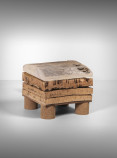Vegetable Matter

Once a symbol of progress, petrochemical matter now poses one of the most significant environmental challenges of modern times. Design and architecture are addressing this issue by rediscovering the potential of plant matter and drawing inspiration from pre-industrial craftsmanship and local materials.
Historically, the use of plant materials to make objects and furniture relied on the availability of local resources, but global trade, often tied to extractivism and colonialism, has led to a constant overexploitation of ecosystems. Contemporary design seeks to reverse this trend by focusing on local materials to reduce the environmental footprint of transport and boost
regional economies. This approach fosters a more respectful relationship with the environment and questions the mindset of using resources in an indiscriminate manner that we are still trying to change.
In the field of architecture, the use of materials such as cross-laminated timber (CLT) and cork in building structures and façades is taking on an increasingly prominent role as alternatives to concrete. In addition to helping reduce emissions from the construction sector, their use paves the way towards regenerative design.


